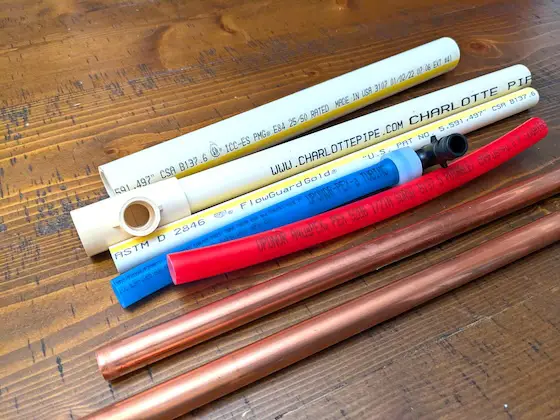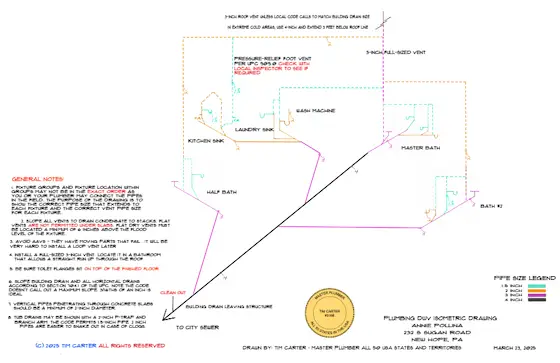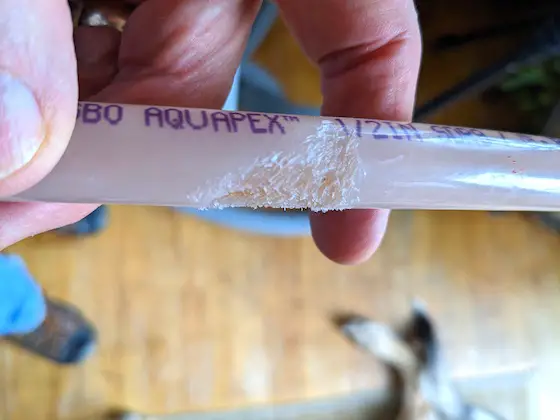Water Lines for House

Water lines - These are your top choices for pipes that deliver water to the faucets in your home. Which is the best one to use? Copyright 2025 Tim Carter
Water Lines for a House - No Clear Winner
I’ve been a master plumber since age 29. I know, it might seem odd to you that a builder is also a plumber. I was attracted to plumbing for several reasons. Designing a plumbing system is a fun and challenging three-dimensional (3D) puzzle. I still draw these 3D riser diagrams for homeowners and builders. The drawings allow them to obtain plumbing permits, and it keeps my tiny gray cells active.

This is a small version of a typical drain, waste, and vent (DWV) drawing I produce for homeowners and architects. CLICK HERE to order yours.
Water lines are not as complicated as drain, waste, and vent lines. That said, you can have volume and pressure problems if you don’t design water systems correctly. A year ago, I did an extensive long-distance phone consultation with a woman. Her plumber tried to supply a luxury shower with 1/2-inch-diameter PEX hot and cold water lines. Water dribbled from the body sprays when the shower head was turned on. GO HERE to read all about this horrible hot mess.
You may be faced with a decision when building a new home, or remodeling an existing one, about what type of water lines you should use. Three different materials dominate the marketplace: copper, PEX plastic, and CPVC - a different type of plastic.
Each one of these materials has pros and cons. It’s important to realize I can’t do a deep dive into each one because of this column’s space limitations. I’m going to hit the high spots for you.
Copper = Durability King
I cut my teeth as a young plumber installing miles of copper water lines. This tubular copper is available in different wall thicknesses: types M, L, and K. Type M is the thinnest and is used for residential work. Type L is a medium-weight copper tube. You’ll discover it being used in commercial and institutional businesses. Type K is thick. The copper water line that runs from the city water main into your home is almost always K copper.
Copper is just below its historic 2024 historic high price of $5.20 per pound. When I soldered my first copper joint in the mid-1970s, copper was selling for 50 cents per pound. As I write this column, copper is selling for about $4.65 per pound. It’s really not out of line when you think that many things are about ten times more expensive than they were fifty years ago.
Soldering copper water lines is time-consuming. It requires great skill, and you must clean all the flux off the exterior of the tubing once it cools down. Many people fail to do this. You can see the green deposits years later.
Not too long ago, copper fittings with rubber o-rings hit the marketplace. Using a tool that presses the fitting onto the copper tube, you can create a leakproof joint in seconds. The fittings, though, are very expensive. The price of the press tool will take your breath away. Watch my video showing how to use a copper press tool:
Copper can corrode. Talk to people in southern California or other locations who have aggressive water. Pinhole leaks form, creating nightmares for homeowners. Copper is also subject to erosion corrosion. The movement of water within the water lines can erode the copper, much like the Colorado River gobbles the Vishnu granite at the bottom of the Grand Canyon.
PEX - Installs Like Electric Cables
PEX plastic is an interesting alternative. I have this tubing in my home. I also installed it in my daughter’s new home. This flexible tubing can be installed like electrical cables. You only have a joint down at a manifold in the mechanical room and at the shutoff valve under your faucet. This home-run installation method uses lots of material.
You can choose to install PEX in a daisy-chain system. This method uses less material and requires fittings like a copper water system. The fittings install much faster than soldering copper. Be aware that PEX water lines tend to have a slightly smaller inner diameter than copper water lines. It’s wise to install 3/4-inch PEX to shower faucets, hose bibs, and other faucets where you need lots of water.
PEX, however, can be devoured by mice. A mouse chewed through a PEX water line at my home several years ago, causing tens of thousands of dollars of damage.

Look how determined the mouse was. I captured the mouse a few days later, and the chubby fellow turned out to be an Olympic swimmer!
CPVC is a product that installs much like copper tubing. This plastic pipe is rigid. You need to cut it and glue the fittings to the tubes. It’s a very DIY-friendly product. That said, think about the chemicals used to prime and cement the tubing to the fittings. I can’t even pronounce the names of them I see on the can labels. Do you want to drink water that courses through pipes where this chemical no doubt has oozed inside the tubes as you glue up a fitting?
A plumber friend of mine told me about CPVC issues he had in a home he bought. The pipes were installed in a crawl space. He entered the crawlspace to inspect the insulation and bumped into one of the CPVC pipes. It fractured and started to leak. When he went to repair it, the CPVC pipe was very brittle. This created a hardship when making the repair.
At least one CPVC manufacturer is ensnared in a large class action lawsuit because of this brittle characteristic. I reached out to them with questions, but their corporate attorneys prevented them from commenting. That’s never a good sign, in my opinion.
Column 1617